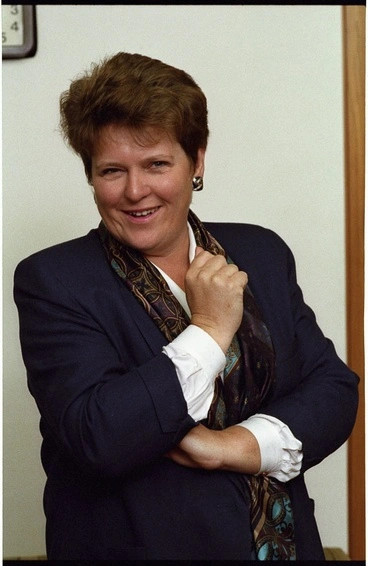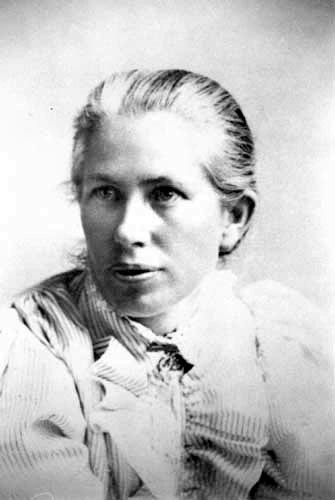Girls can do anything
A DigitalNZ Story by National Library Services to Schools
This poster was part of an action campaign in the 1980s to get women into non-traditional careers and jobs (like carpentry and butchery) that at the time were male dominated.
These resources and text relate to the ‘Girls can do anything’ poster and the wider context of gender pay equity and male and female occupations. They have been sourced and collated from DigitalNZ and other websites.
Fiona Lapsley, apprentice motor mechanic, Rosscars Toyota.
Upper Hutt City Library
Girls can do anything
Manatū Taonga, the Ministry for Culture and Heritage
Hairdressing apprentice
Manatū Taonga, the Ministry for Culture and Heritage
Background
It made economic sense for women to break out of traditional, narrow occupational choices – ‘men’s work’ tended to be better paid and was more likely to offer the chance to build a business or career. It was generally more prestigious, and in some cases allowed more independence, than equivalent ‘women’s work’. By the mid-1980s, when this poster was produced by the government's Employment and Vocational Guidance Service, the idea of girls doing anything had become widely accepted.
Source: Megan Cook, 'Women’s movement - Health, fertility and education', Te Ara - the Encyclopedia of New Zealand, http://www.TeAra.govt.nz/en/ephemera/27921/girls-can-do-anything (accessed 1 August 2018)
Agriculture modern apprentice
Manatū Taonga, the Ministry for Culture and Heritage
Apprentices and industry trainees, 1930–2008
Manatū Taonga, the Ministry for Culture and Heritage
Context
This Girls Can Do Anything poster came from a 1984 Labour Department programme initiative called, Positive Action Programme for Women.
The campaign idea was to widen the work opportunity for women in non-traditional female work careers like surveying, building, welding, plumbing, and butchery.
This was achieved by promoting women into apprenticeships. In late 1985 over 300 women had taken up apprenticeships in non-traditional jobs.
1980s
By 1981 one-third of married women were in full-time employment, nearly twice the proportion in 1961. Women continued to dominate professions such as nursing and primary teaching, but by 1981 they also accounted for a fifth of lawyers and doctors, compared to 3% a generation earlier.
Though separate pay scales for men and women had been abolished in 1972, in 1985 women were still paid 22% less per hour than men. In 1980 the New Zealand Federation of Labour adopted the Working Women’s Charter, sometimes called a ‘bill of rights’ for working women. By the mid-1980s the government’s Employment and Vocational Guidance Service was actively promoting the catch-cry, 'Girls Can Do Anything’.
Source: 'Overview', URL: https://nzhistory.govt.nz/culture/the-1980s/overview, (Ministry for Culture and Heritage), updated 10-May-2018
Fertile questions
What jobs are these women not doing? Why not?
Have common occupations for women changed over time?
What is work and why do we do it?
What is this poster really saying?
What is your question?
Quick facts
- In 2013 women in managerial roles tended to be concentrated in female-dominated industries like nursing, teaching, and childcare.
- Many female workers in New Zealand work in occupations that are more than 80% female
- On 15 August 2018, StatsNZ announced that the gender pay gap was 9.2 percent. The gender pay gap indicates the difference between women and men’s earnings.
- Women have been increasing their representation in the physical, mathematical, and engineering science professionals group, up from 9 % in 1991 to 21 % in 2013.
- In 2018 the New Zealand legal profession has more currently practising women lawyers than male lawyers.
- In the latest published figures, the New Zealand Defence Force has higher female representation in the Regular Forces than the US, Australia, Canada or the UK.
WOMEN IN THE PROFESSIONS. (Taranaki Daily News 24-9-1910)
National Library of New Zealand
WOMEN AND THE PROFESSIONS. (Tuapeka Times 28-6-1913)
National Library of New Zealand
Other resources
Boys and girls — girls and boys share their thoughts on gender stereotypes.
Boys and girls on stereotypes— girls and boys share their thoughts on stereotypes.
Child experiment— gender equality and reward video.
Girls can do anything — Go Girl: a storybook of epic NZ women features 48 real-life go-getters.
Girls can do anything — thirty-nine years ago, New Zealand 16-year-old girls wanted more than anything to become air hostesses.
Girls can do anything? — women and industry training in New Zealand.
Girls can do anything? — women and industry training in New Zealand.
Rachel Stewart— New Zealand’s first female railway locomotive driver.
Sybil Lupp— NZ Mechanic, motor-racing driver and garage owner.
The Men Who Take 'Women's' Jobs— men who once worked in manufacturing are finding new careers.
Women in trades— case studies of young NZ women working in the trades.
Jenny Shipley
Manatū Taonga, the Ministry for Culture and Heritage
Sybil Lupp
Alexander Turnbull Library
Kate Edger
Manatū Taonga, the Ministry for Culture and Heritage
New Zealand's first woman doctor registered
Manatū Taonga, the Ministry for Culture and Heritage
This story was compiled and curated by Te Puna Mātauranga o Aotearoa | National Library of New Zealand, Services to Schools staff, in 2019.




